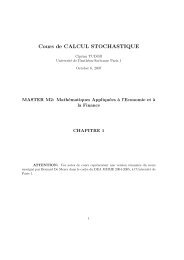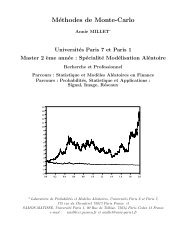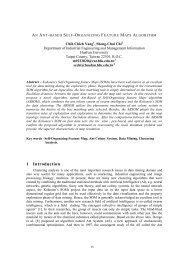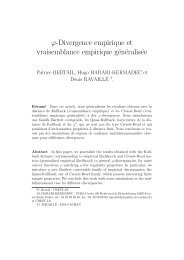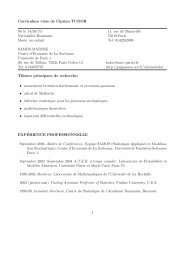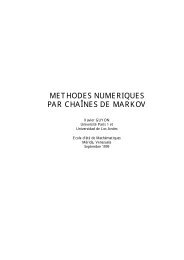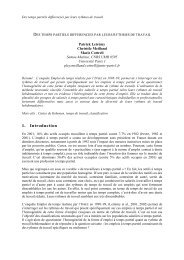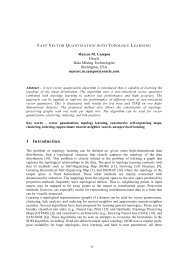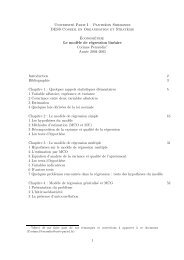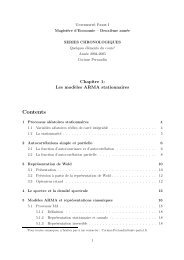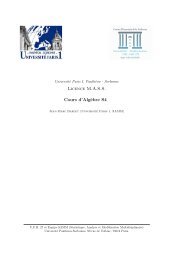Parameter estimation for stochastic equations with ... - samos-matisse
Parameter estimation for stochastic equations with ... - samos-matisse
Parameter estimation for stochastic equations with ... - samos-matisse
Create successful ePaper yourself
Turn your PDF publications into a flip-book with our unique Google optimized e-Paper software.
standard one, Malliavin calculus, and Gaussian regularity theory. A related work on<br />
a two-parameter model <strong>with</strong> standard Brownian sheet is the paper [2].<br />
The paper is organized as follows. Section 2 contains some preliminaries on the<br />
fractional Brownian sheet. In section 3, using the techniques of the Malliavin calculus,<br />
we prove that the solution is sub-Gaussian. Section 4 contains the proof of the<br />
existence of the MLE <strong>for</strong> the parameter θ and we separate this proof following the<br />
values of α and β . Finally, in Section 5, we present a different expression of the MLE<br />
and relate our work <strong>with</strong> the approach of [7].<br />
2 Fractional Brownian sheet as a Volterra sheet<br />
We recall how the fractional Brownian sheet W α,β can be represented by a standard<br />
Brownian sheet W = W 1 2 , 1 2 that is constructed from it. For details and references<br />
see [14, 15].<br />
We start <strong>with</strong> the one-parameter case. Define a Volterra kernel (i.e. a kernel<br />
which vanishes if the second variable is greater than the first one)<br />
( ( ) t α−<br />
1<br />
∫ )<br />
2<br />
K α (t, s) = c α (t − s)<br />
α− 1 1<br />
t<br />
2 − (α −<br />
s<br />
2 )s 1 2 −α u α− 3 2 (u − s)<br />
α− 1 2 du ,<br />
where the normalising constant is<br />
√<br />
(2α + 1 2<br />
c α =<br />
)Γ( 1 2 − α)<br />
Γ(α + 1 2<br />
)Γ(2 − 2α)<br />
and Γ is the Euler’s gamma function. It was shown in [10] that the fractional Brownian<br />
motion W α <strong>with</strong> Hurst index α ∈ (0, 1) can be represented by using a standard<br />
Brownian motion W = W 1 2 as<br />
W α t =<br />
∫ t<br />
0<br />
K α (t, s) dW s .<br />
This Wiener integral can be understood both in pathwise and L 2 -sense. The Brownian<br />
motion W is actually constructed from the fractional one by the (pathwise or<br />
L 2 ) integral<br />
Here the Volterra kernel K −1<br />
α<br />
Kα<br />
−1 (t, s) = c ′ α<br />
W t =<br />
is<br />
( ( t<br />
s) α−<br />
1<br />
2<br />
(t − s)<br />
1<br />
c ′ α =<br />
and B is the beta function.<br />
∫ t<br />
0<br />
K −1<br />
α (t, s) dW α s .<br />
2 −α − (α − 1 2 )s 1 2 −α ∫ t<br />
Γ(α + 1 2<br />
)Γ(2 − 2α)<br />
√<br />
,<br />
B( 1 2 − α) (2α + 1 2 )Γ( 1 2 − α)<br />
2<br />
s<br />
s<br />
u α− 3 2 (u − s)<br />
1<br />
2 −α du<br />
)<br />
,



